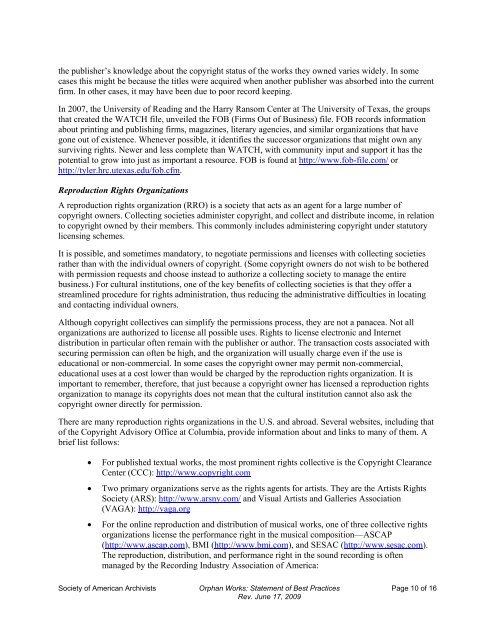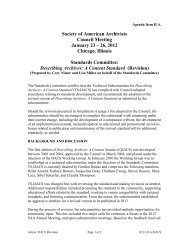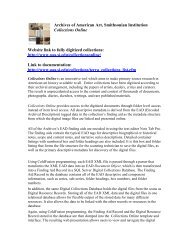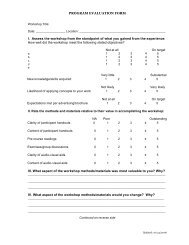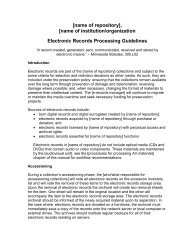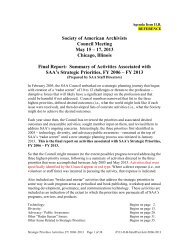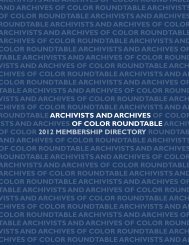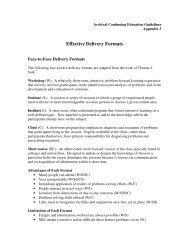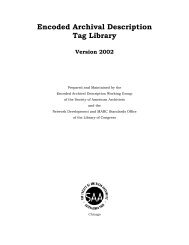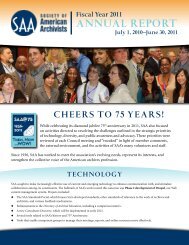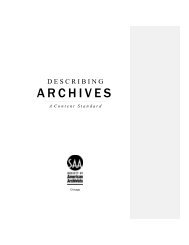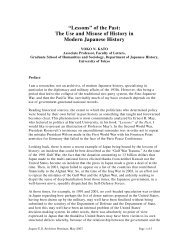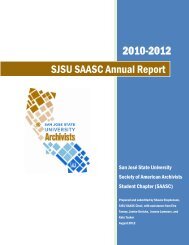Society of American Archivists - US Copyright Office
Society of American Archivists - US Copyright Office
Society of American Archivists - US Copyright Office
Create successful ePaper yourself
Turn your PDF publications into a flip-book with our unique Google optimized e-Paper software.
the publisher’s knowledge about the copyright status <strong>of</strong> the works they owned varies widely. In somecases this might be because the titles were acquired when another publisher was absorbed into the currentfirm. In other cases, it may have been due to poor record keeping.In 2007, the University <strong>of</strong> Reading and the Harry Ransom Center at The University <strong>of</strong> Texas, the groupsthat created the WATCH file, unveiled the FOB (Firms Out <strong>of</strong> Business) file. FOB records informationabout printing and publishing firms, magazines, literary agencies, and similar organizations that havegone out <strong>of</strong> existence. Whenever possible, it identifies the successor organizations that might own anysurviving rights. Newer and less complete than WATCH, with community input and support it has thepotential to grow into just as important a resource. FOB is found at http://www.fob-file.com/ orhttp://tyler.hrc.utexas.edu/fob.cfm.Reproduction Rights OrganizationsA reproduction rights organization (RRO) is a society that acts as an agent for a large number <strong>of</strong>copyright owners. Collecting societies administer copyright, and collect and distribute income, in relationto copyright owned by their members. This commonly includes administering copyright under statutorylicensing schemes.It is possible, and sometimes mandatory, to negotiate permissions and licenses with collecting societiesrather than with the individual owners <strong>of</strong> copyright. (Some copyright owners do not wish to be botheredwith permission requests and choose instead to authorize a collecting society to manage the entirebusiness.) For cultural institutions, one <strong>of</strong> the key benefits <strong>of</strong> collecting societies is that they <strong>of</strong>fer astreamlined procedure for rights administration, thus reducing the administrative difficulties in locatingand contacting individual owners.Although copyright collectives can simplify the permissions process, they are not a panacea. Not allorganizations are authorized to license all possible uses. Rights to license electronic and Internetdistribution in particular <strong>of</strong>ten remain with the publisher or author. The transaction costs associated withsecuring permission can <strong>of</strong>ten be high, and the organization will usually charge even if the use iseducational or non-commercial. In some cases the copyright owner may permit non-commercial,educational uses at a cost lower than would be charged by the reproduction rights organization. It isimportant to remember, therefore, that just because a copyright owner has licensed a reproduction rightsorganization to manage its copyrights does not mean that the cultural institution cannot also ask thecopyright owner directly for permission.There are many reproduction rights organizations in the U.S. and abroad. Several websites, including that<strong>of</strong> the <strong>Copyright</strong> Advisory <strong>Office</strong> at Columbia, provide information about and links to many <strong>of</strong> them. Abrief list follows:For published textual works, the most prominent rights collective is the <strong>Copyright</strong> ClearanceCenter (CCC): http://www.copyright.comTwo primary organizations serve as the rights agents for artists. They are the Artists Rights<strong>Society</strong> (ARS): http://www.arsny.com/ and Visual Artists and Galleries Association(VAGA): http://vaga.orgFor the online reproduction and distribution <strong>of</strong> musical works, one <strong>of</strong> three collective rightsorganizations license the performance right in the musical composition—ASCAP(http://www.ascap.com), BMI (http://www.bmi.com), and SESAC (http://www.sesac.com).The reproduction, distribution, and performance right in the sound recording is <strong>of</strong>tenmanaged by the Recording Industry Association <strong>of</strong> America:<strong>Society</strong> <strong>of</strong> <strong>American</strong> <strong>Archivists</strong> Orphan Works: Statement <strong>of</strong> Best Practices Page 10 <strong>of</strong> 16Rev. June 17, 2009


